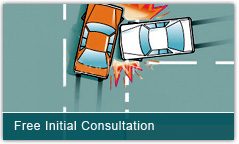Pedestrian Involvements
Forensic Dynamics has extensive experience in reconstructing motor vehicle collisions involving pedestrians. When these types of events arise, we use our understanding of projectile theory to calculate the speed of impact based on how far the pedestrian is thrown or how far the body slides on the surface. The stopping distance of the vehicle from point of impact to its rest location is reviewed to determine whether it may have occurred before or after braking began. The amount of damage to the subject vehicle and the overall injury severity of the pedestrian is compared with the literature to provide further indication of the likely speed of impact. Finally, software packages that have become available recently, such as PC Crash, enable us to further refine impact speed and pedestrian walking velocity. Modeling the precise car involved and also the precise height of the pedestrian, the simulation package can predict, for example, where the head or elbow strike would occur on the vehicle for any given speed. This prediction can be compared with the actual vehicle damage measurements to determine if the damage to the actual vehicle correlates to the simulated (virtual) vehicle from the computer model.
Often we are asked to address the issue of conspicuity and whether the driver perceived and responded to the hazard created by the pedestrian in reasonable time (the perception/ response time).
To assess this, we will return to the scene under identical conditions and outfit a surrogate pedestrian in near-identical clothing in order to best approximate what the driver would have faced. Similarly, attempts are made to use the same vehicle and sky conditions as when the accident occurred so that the most appropriate visualization experiment can be undertaken. Based on the physical evidence reviewed and the calculations which follow, the perception response time of the driver in question can be compared to the expected response from the literature based on a host of factors a driver must typically deal with. Recently, computer programs have become available which predict with much greater precision the perception response time of a “typical” motorist by taking into account far more variables than the age-old “alerted” or “unalerted” motorist.
Finally, if it is determined that the actions of the pedestrian or driver could have been better, we analyze the “what if” scenario to determine how this would have affected the eventual outcome of the incident.





